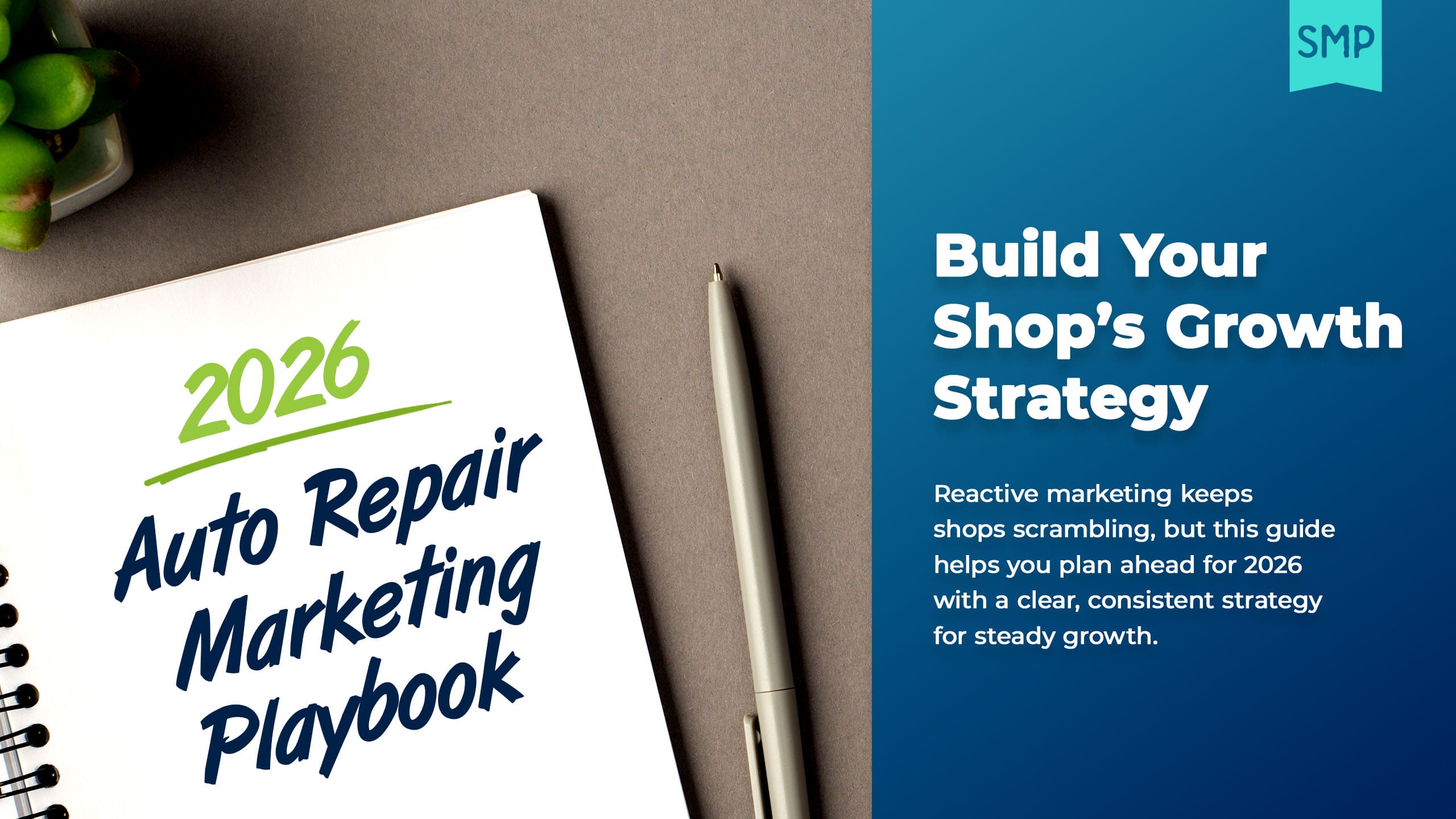Marketing isn’t the wrench you grab last-minute when nothing else works. It should be part of your daily toolkit, the one you reach for before problems even arise.
Reactive marketing keeps your shop in constant scramble mode. The shops that see steady growth don’t wait for empty bays to push out a last-minute special. They take a proactive approach, mapping out a clear marketing playbook before problems show up.
If you want your auto repair business to grow in 2026, that planning starts now, not after the holidays and not when the schedule is already thin. This guide shows you how to review your 2025 performance, create a strategy that works quarter by quarter, and build a proactive marketing plan that gives you clarity, consistency, and growth all year long.
Why Auto Repair Marketing Plans Should Start Now
Every year we see it. Shops that put off planning fall into reactive mode. The kind where the calendar drives the decisions instead of the other way around. That’s when things start slipping through the cracks.
You’ve seen it:
- “We need cars in bays next week. Run an ad!”
- “Let’s throw out a tire special and hope someone bites.”
- “Can someone post something on Facebook real quick?”
It’s not that these things don’t sometimes work. But if this is your strategy, you’re playing defense all year. That’s not marketing. That’s guesswork with a deadline.
That reactive cycle comes at a cost to your time, your margins, and your team’s energy. You can’t build consistency or momentum when every week is a fire drill.
A strong auto repair marketing plan gives you control. It turns the guessing game into a roadmap. You know what’s coming, what message you’re putting out, and what results you’re aiming for. It gives your team clarity and your clients confidence.
It also makes decisions easier. You hire with purpose. You order parts ahead of time. You stop scrambling to “fill the schedule” because the schedule starts filling itself. That’s how real growth happens on purpose, not by accident.
Reflect on 2025: What Worked, What Didn’t, and Why It Matters
Before you move into 2026, take a hard look at the year you’re closing out. Think like a tech diagnosing a comeback. You don’t fix the issue by assuming. You pop the hood, you check the numbers, and you track the pattern.
Too often, shop owners run on gut feeling: “We were busy,” or “It felt like a good quarter.” But busy doesn’t always mean profitable, and good isn’t always sustainable. You’ve got to dig in.
Ask yourself:
- Did our average repair order increase?
- Did we attract the kind of clients we want?
- Were we visible when people searched for us online?
- Did our content build trust or just fill space?
This isn’t about pointing fingers. It’s about identifying the wins and understanding the gaps. That clarity is what separates growing shops from stagnant ones.
Don’t just look at your marketing numbers. Ask the bigger questions. Did your team grow this year, or were you stretched thin? Were you booked solid because of demand or because your workflow slowed everything down?
This kind of honest review is what separates shops that grow with intention from the ones riding on luck. And luck’s not a strategy.
Pro Tip: Your 2025 performance data is a diagnostic goldmine. Don’t leave it sitting in the file drawer.
Why a Marketing Playbook Matters More Than a Promotion Calendar
We believe in long-term planning because it creates long-term clients.
That’s why we host our annual Plan With The Pros (PWTP) event. It’s not a seminar, it’s a strategy session. You sit down with our team and other serious shop owners to build your actual 2026 marketing plan. We walk through your calendar quarter by quarter, mapping real campaigns with real timelines.
If you’ve never been to PWTP, think of it like a timing light for your marketing. It aligns everything so your efforts fire when and where they should. It’s not theory. Its execution.
But don’t just take our word for it, here’s what a few of last year’s attendees had to say:
“Step out of your comfort zone. You can only learn what you put yourself out there to learn, and being uncomfortable is something that teaches you. Being able to do it in a group of people like this is a once-in-a-lifetime opportunity, really.”
– Kristy Burris, Frog Pond Performance
“It’s going to give you all the tools that you need for everything to give you that plan for next year.”
– Savannah Garrett, Schmidt Auto Care
“To tell you the truth, I cannot think of anything. I really appreciated all Kim & Caroline did for this event. You girls are spot on!”
– Paula Jean Schuh – when asked what she would change about the event
This is real feedback from real shop owners who showed up, put in the work, and walked out with clarity and confidence for the year ahead.
Reactive vs. Proactive Auto Repair Marketing
Most shop owners fall into one of two categories: they’re either reacting week to week, or they’re planning with purpose. Reactive marketing feels like putting out fires. Proactive marketing feels like running a playbook.
Here’s the difference side by side:
Reactive vs. Proactive Auto Repair Marketing
| Reactive Marketing | Proactive Marketing Playbook |
|---|---|
| Last-minute specials when bays are empty | Campaigns mapped out by season & quarter |
| Posts thrown on social “just to post” | Content designed to build trust & connect with clients |
| Running ads only when things slow down | Ads scheduled to align with shop goals |
| Team feels pressure and uncertainty | Team has clarity, direction, and confidence |
| Growth depends on luck and timing | Growth is predictable, sustainable, and intentional |
When you see it laid out, the choice is obvious. Reactive marketing drains your time, your margins, and your team’s energy. A proactive playbook creates predictability, clarity, and growth you can count on.
So how do you shift from reactive habits to a proactive playbook? It starts with setting real goals, mapping out seasonal focus areas, and building a strategy you can actually scale.
From Reactive to Proactive: Building Your 2026 Marketing Playbook
Now that you’ve seen the difference between reactive guesswork and proactive planning, here’s how to build a strategy that scales with your shop’s goals.
Reactive Guessing vs. Proactive Goal-Setting
“Do better next year” isn’t a plan. Define real revenue and car count goals, then reverse-engineer what it takes to hit them. That’s how you turn vague hopes into measurable growth.
If your goal is to add $500k in revenue, break that down. How many more cars do you need in the bays? What does your average repair order need to be? Where are those customers coming from?
This is where most shops get stuck. They don’t slow down long enough to do the math. But when you break it down, the numbers tell you exactly what kind of marketing support you’ll need to make it happen. It turns guesswork into a game plan.
Map Out Quarterly Focus Areas
Marketing isn’t one-size-fits-all, and it definitely doesn’t run on autopilot. Shops that don’t plan often default to generic specials, but proactive shops build seasonal campaigns that match what their customers need. Every season brings different behaviors, needs, and opportunities. Tax season might be your time to push bigger ticket items. Summer is all about road trips and A/C checks. Back-to-school means oil changes and safety inspections.
If your message is the same in July as it is in November, you’re missing the moment. Mapping out your marketing themes by quarter lets you plan campaigns that connect. That’s how you stay ahead. For a deeper dive into how to build marketing that reflects what’s happening month to month, check out our podcast episode on Monthly Marketing Strategy and why timing matters.
Define Your Channels and Their Role
Not all marketing tools do the same job. SEO helps you get found when people are searching. Social media builds familiarity and trust. Google Ads get you visibility right when the buyer’s ready. Email keeps your current clients warm. Referral programs turn happy clients into growth.
Relying on just one channel is a reactive move; using each channel with purpose is how proactive shops maximize impact.
If you’re throwing all your efforts at one channel, you’re leaving results on the table. Think of it like a well-equipped toolbox. You wouldn’t use a pry bar to do electrical. Know what each channel is built for and use them with purpose.
Build Content That Builds Trust
Reactive content checks a box, but proactive content builds credibility and shows clients why they should choose your shop.
Your ideal clients don’t want cheap. They want reliable. They want confident, clear, no-BS expertise. They want to see that your shop is the kind of place where things are done right the first time. Your content should reflect that.
This isn’t about slick sales pitches or generic posts. It’s about real stuff. Photos of your techs working on diagnostics, videos explaining common issues, and testimonials that sound like your actual customers. When you show what it’s like behind the scenes, people start to believe in what you’re doing.
Track, Review, Adjust
A solid plan is only as good as your ability to adapt. Don’t wait until Q4 to figure out what flopped in Q2. Watch the numbers, listen to the feedback, and make adjustments while it still counts.
Think of your marketing like an engine you’re tuning. When something feels off, pop the hood and get to work. One small tweak can lead to a big improvement. The longer you wait, the worse it gets. Regular check-ins keep the whole thing running smoothly.
Reactive shops wait until the year is over to course-correct. Proactive shops check results often and make small tweaks that keep growth on track.
Don’t Let Planning Happen in a Vacuum
One of the biggest mistakes we see is shop owners trying to plan everything alone. You stare at a blank calendar, overthink every step, and either create an overcomplicated plan or abandon it altogether.
You’re not meant to do this in isolation.
The best strategies are built through conversation, collaboration, and outside perspective. Whether it’s a trusted business coach, your leadership team, or our crew at Shop Marketing Pros, bring others into the process. You’ll create a more effective plan and have people who help you stay accountable.
Planning Today Means Predictability Tomorrow
A well-built plan doesn’t just help you grow. It helps you sleep at night. When you know what’s ahead, that daily mental scramble starts to fade. Your service advisor isn’t guessing what to promote next week. Your techs aren’t waiting around for work to come in. Your team has direction, and that makes all the difference.
Think of your marketing plan like a service schedule for a vehicle. You don’t wait for the engine light to come on before doing maintenance. You check the oil, rotate the tires, and change the filters on a schedule because you know it keeps the car running smoother, longer. The same goes for your business. Planning is how you avoid breakdowns.
Predictability isn’t boring. It’s what gives you the freedom to be a better leader, to hire with confidence, and to make decisions without constantly looking over your shoulder. It’s what creates stability in the chaos of running a shop.
That’s where real growth happens. Not just in revenue, but in how you lead, how your team performs, and how your shop earns a reputation that keeps cars and quality clients coming through the door.
FAQs: Auto Repair Marketing & PLAN With The Pros
When should I start planning my 2026 auto repair marketing?
The best time to plan is now. Shops that wait until January often find themselves reacting to empty bays instead of working from a clear roadmap. Starting early means you enter the new year with momentum and direction.
What is the difference between a promotion calendar and a marketing playbook?
A promotion calendar focuses on one-off deals, while a marketing playbook outlines strategy, campaigns, and goals for the entire year. The playbook gives your shop consistency and predictability instead of reactive guesswork.
What is Plan With The Pros (PWTP)?
Plan With The Pros is our annual strategy event where shop owners sit down with our team to map their marketing plan for the year ahead. Instead of generic advice, you leave with a quarter-by-quarter playbook built around your goals.
How does PWTP benefit my shop long-term?
PWTP ensures you’re not just reacting to slow weeks or throwing out random specials. You’ll have a strategic plan that aligns with seasonal opportunities, supports your revenue goals, and gives your team clarity on what’s next.
Do I need to attend PWTP if I already have a marketing partner?
Yes, because PWTP is about strategy, not just execution. Even if you have a partner, this session helps align your team, set measurable goals, and ensure your marketing stays on track all year.
Build Your 2026 Auto Repair Marketing Plan with Shop Marketing Pros
If you want different results in 2026, you need a different approach. Hope isn’t a plan. But clarity is.
At Shop Marketing Pros, we don’t just talk marketing. We build real strategies that help auto repair shops like yours grow with purpose, predictability, and confidence. From quarter-by-quarter planning to execution that actually gets results, we’re here to help you take the guesswork out of your marketing.
Want to know what it looks like to have a real marketing plan that supports your goals and gets your team on the same page?
Schedule a free discovery call today. No fluff. No pressure. Just a conversation about what’s possible when you stop reacting and start leading with a strategy.
Your shop deserves more than last-minute specials and social posts thrown together on a Monday morning. Let’s build a plan that actually drives growth in 2026.
Brian Walker
“Digging in and figuring out why a business’ marketing isn’t working is a lot like it was when he was elbows deep into a car that no one else could fix. When you figure it out, there’s nothing else like it.”
To get to do this for auto repair shop owners combines his passions, and he couldn’t be more excited about helping shop owners.


